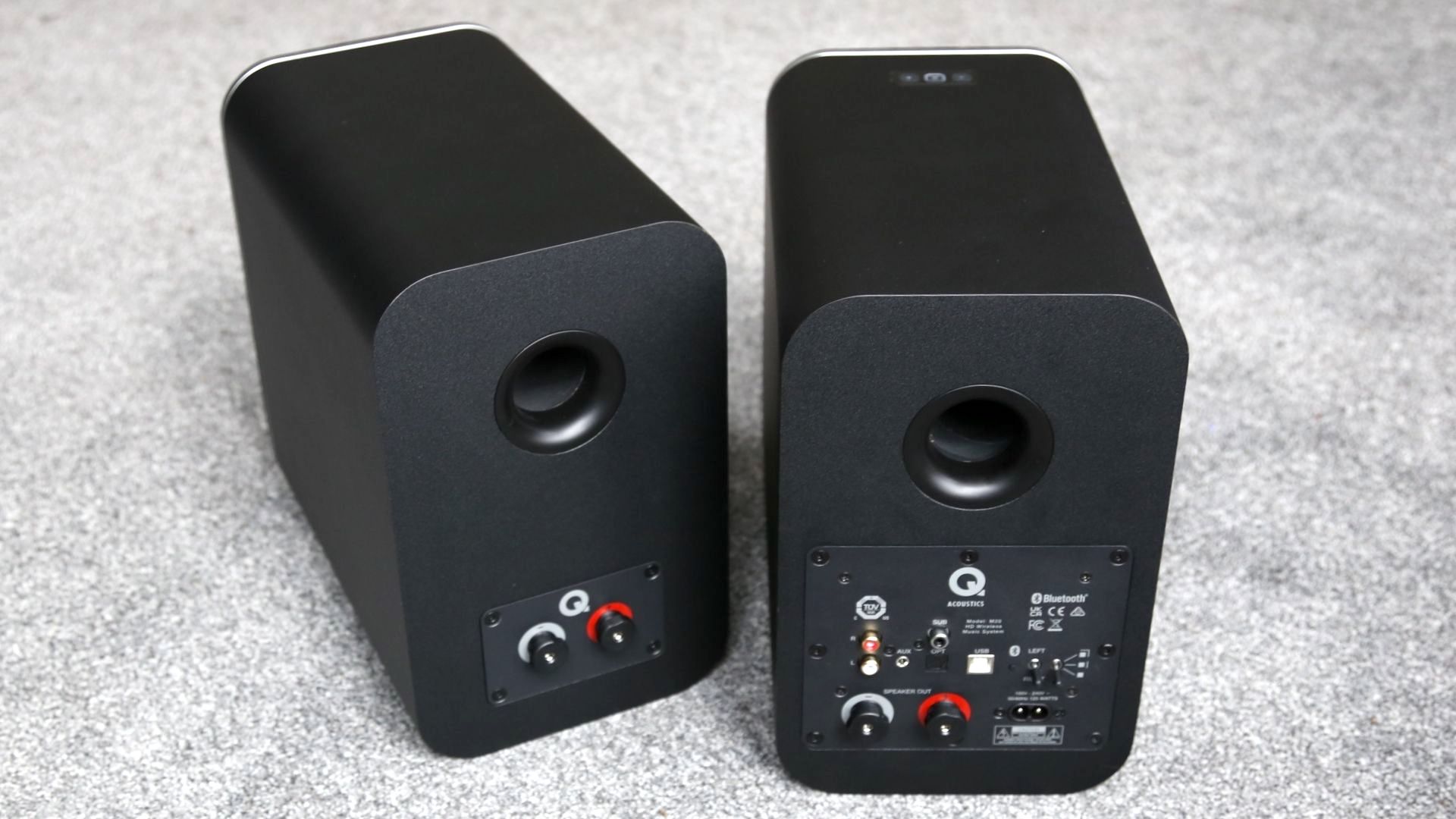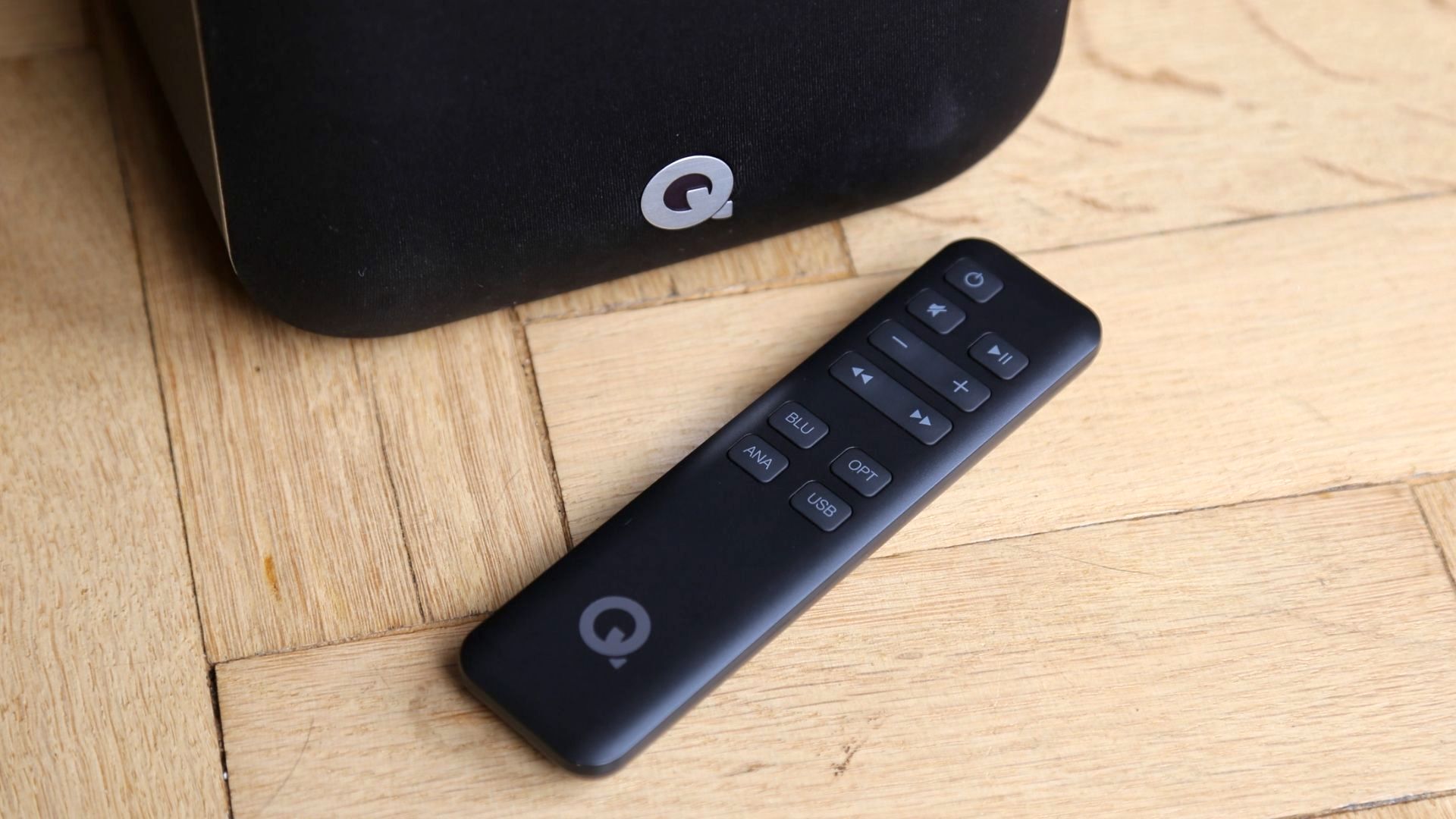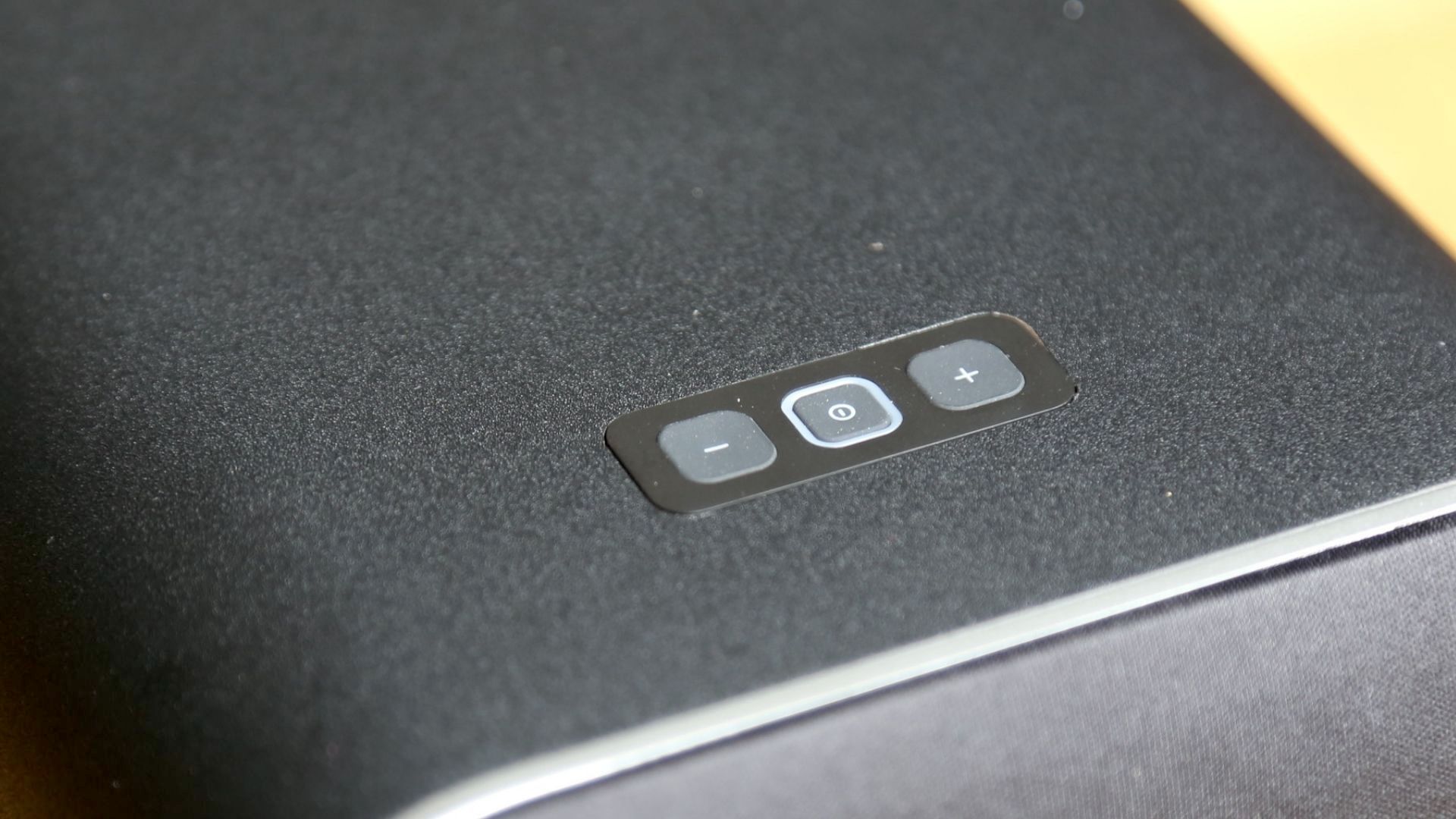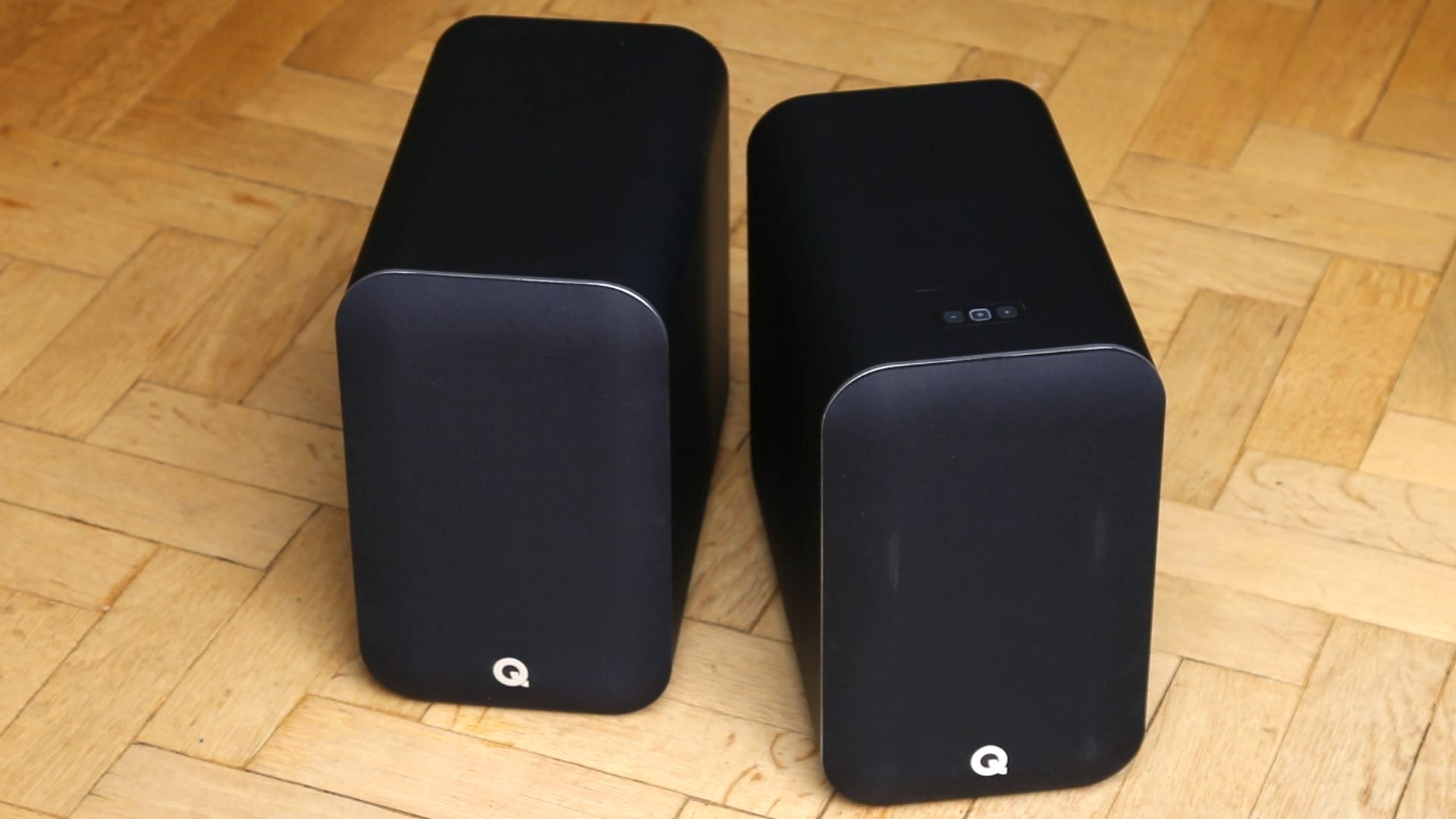Q Acoustics M20 HD wireless music system
Why choose a soundbar when you can have a good-looking pair of bookshelf speakers with a built-in digital amplifier instead? Delivering plenty of extra depth (which always leads to a more dynamic sound), British audio company Q Acoustics presents the M20 HD ‘wireless’ music system.
It’s actually nothing of the sort, with a speaker cable linking one unit to the other, as well as a power cable and a vast pantheon of cabled options on the back of the active speaker. In fact, the only thing wireless about the M20 HD is that it supports Bluetooth streaming. Nevertheless, the M20 HD is great at what it does. If you’re as much into music as you are TV, the system’s warm digital sound, treble detail and balanced sound delivers an ideal all-round soundstage that’s as adept with Nirvana as it is with Netflix.
Bluetooth streaming – complete with aptX HD – impresses, too, with the M20 HD consequently capable of handling compressed audio files. In addition, a remote control offers fine control over the volume, the speakers work well when music is played very quietly (the reality of living in a shared household), and the powered speaker can either be the right or left channel, depending on where the mains outlet is in a room.
There are a few niggles, such as the lack of HDMI ARC, but the M20 HD offers an impressive and easy to set up upgrade to your living room’s soundstage – and one that can just as easily be moved to a games room or a home office. As a ‘first music system’ for literally any room in a home, and for any kind of home entertainment, the versatile M20 HD is an exciting prospect.
Price and availability
- Costs $599 / £399 / AU$900
- Out now
- Sold by independent dealers
The Q Acoustics M20 HD wireless music system originally went on sale in August 2021 in the UK and in September 2021 in the US. It sells for $599 / £399 / AU$900 from the Q Acoustics websites (www.qacoustics.co.uk and www.qacoustics.com) and local independent dealers.

Design and setup
- Elegant curved design
- Speaker cable required
- Powered speaker can be either left or right channel
There are two speakers in the package, one active (with a digital amplifier inside) and one passive. Both measure 279 x 170 x 296mm, with the active speaker weighing 5.5kg and the passive speaker 5.1kg.
Both have a 2.2cm tweeter and 12.5cm mid/bass driver with a bass reflex port at the rear, which will disperse low-frequency sound if you place them away from a wall. However, if you plan to use the M20 HD on a bookshelf, with little or no space between them and the wall, Q Acoustics supplies a couple of foam muffles in the box to insert into the bass reflex ports to dampen any distorted bass.
Although you can put these powered loudspeakers anywhere, including on a bookshelf, desk or TV table, at 11 inches/285mm deep, this won’t always be easy.

Q Acoustics might call the M20 HD wireless, but this is restricted only to Bluetooth streaming. Elsewhere, the M20 HD system involves significant cabling. In the box is a mains cable for the active speaker and a four-meter speaker cable for linking up the active and the passive speakers via binding posts on the reverse of each. The active speaker essentially powers the passive speaker.
On the rear of the active speaker you’ll find a number of connections. There’s a choice of an optical audio input, a brace of left and right stereo audio analogue inputs, and an auxiliary 3.5mm stereo jack, all for attaching to a TV, Blu-ray player, set-top box, record player or an AV amplifier.
For hooking up a PC, there’s a USB-B slot at the back of the active speaker, which enables a high-performance data transfer speed. Cue 24bit/192kHz high-res music via USB from a PC, which is also possible over optical audio. However, it would have been nice to see such an unusual cable provided in the box, since few will have one.
There’s also an analogue input for attaching a separate subwoofer, although we’re not convinced the M20 HD needs one, particularly if you intend to feed it a diet of TV, music and gaming.
The good news is that the two speakers in the package – as mentioned, one active that needs to be attached to the mains, and the other passive, which doesn’t – can act as left or right. There’s a switch on the rear of the active speaker to determine whether it acts as the left or right channel. That makes placement far easier, since you can have an active speaker close to whatever power outlet is most convenient. It isn’t a feature we’ve seen before on similar products.

Performance
- 2 x 65W power
- Enjoyable plug-and-play sound quality
- Impressive Bluetooth streaming
Bluetooth music streaming is lossy. It’s highly compressed data that to our ears isn’t just a case of ‘convenience over quality’, but almost always worth avoiding at all costs. However, Bluetooth streaming on the M20 HD isn’t at all terrible.
Thankfully, it’s aptX HD-capable – which doesn’t mean it magically creates high-resolution audio. However, it does make tunes streamed over Bluetooth from a smartphone listenable. Of course, this will depend on the type of music you play, but the M20 excels with uncomplicated fare, such as acoustic music.
The M20 HD’s main job is really to beef up the audio from a TV or home cinema, and in that regard it performs really well. We hooked it up to a Virgin Media set-top box via an optical audio cable and enjoyed the depth, warmth and precision of the M20 HD’s stereo soundscape. There’s plenty of low-frequency action, but it never seems overdone or isolated.
Stereo imaging is excellent, too, with distinct left-right channels with dialogue firmly in the centre. Not only does its immaculate mid-range offer a huge improvement over a flatscreen TV’s sound quality, its warm digital sound is also really well suited to music. However, it’s worth noting that there aren’t any virtual surround sound modes, as you find on some soundbars; the M20 HD is all and only about stereo.
In the box, Q Acoustics supplies a small remote control, which impresses. This 2 x AAA battery-powered unit features surprisingly sensitive volume buttons that offer unexpectedly fine control. Most impressively, the M20 HD can be operated very quietly, which is rare for powered audio devices, most of which have a rather loud minimum volume.
What we did notice during the review was that the M20 HD switches itself off when a connected TV is switched off, but doesn’t wake unless you use the remote or physically go over to the powered speaker to press the standby button. That does mean a few moments of silence after you switch on the TV, which can become a little annoying.
The above is one of the few low points on an all-round audio product for home entertainment that barely puts a foot wrong – albeit one that perhaps lacks ambition.

Should I buy the Q Acoustics M20 HD?
Buy it if…
You want to improve your TV’s built-in speakers
Tired of your TV’s thin, weedy and downright dull-sounding tweeters? The M20 HD delivers a significant improvement on the majority of built-in TV audio systems.
You want some serious sonics for PC gaming or from vinyl
Although the M20 HD seems most at home in a living space, most likely placed either side of a TV or paired with a desktop PC, these bookshelf-style speakers will do a great job with a record player, too.
Don't buy it if…
You already have a decent soundbar
Although you could argue that the M20 HD’s stereo imaging is worth the investment, if you already have one of the best soundbars in front of your TV then it’s unlikely to rock your world. Particularly since it doesn’t include any quasi-surround modes, which your soundbar probably does.
You want something wireless
Although the ‘wireless music system’ moniker might have you believe otherwise, this speaker package actually requires a lot of cabling, including a long stretch of speaker cable and a mains cable, plus whatever sources you cable it up to. The only thing wireless about it is Bluetooth streaming.
- Here's our list of the best soundbars you can buy today
0 comments:
Post a Comment